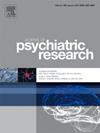The impact of indirect structure on functional connectivity in schizophrenia using a multiplex brain network
IF 3.7
2区 医学
Q1 PSYCHIATRY
引用次数: 0
Abstract
It is known that abnormal functional connectivity (FC) in schizophrenia (SZ) is closely related to structural connectivity (SC). We speculate that indirect SC also have an impact on FC in SZ patients. Conventional single-layer network has limitations for studying the relationship between indirect SC and FC. Thus, this study constructed a multiplex network based on structural connectivity and functional connectivity (SC-FC). The SC-FC bandwidth and SC-FC cost are used to analyze the impact of indirect SC on FC. Moreover, this paper proposed mediation ability, mediation cost, mediated strength and mediated cost to quantify the effects of mediator nodes and mediated nodes on indirect SC. The results show that SZ patients exhibit lower SC-FC bandwidth and SC-FC cost compared to healthy controls (HC), which could be caused by the limbic and subcortical network (LSN), default mode network (DMN) and visual network (VN). The mediator and mediated nodes in indirect SC of SZ patients also showed diminished effects. These findings suggest that functional communication ability and cost in SZ patients are influenced by indirect SC. This study provides new perspectives for understanding the relationship between indirect SC and FC, and provides strong evidence for interpreting the physiological mechanisms of SZ patients.
利用多重大脑网络研究间接结构对精神分裂症功能连接的影响
众所周知,精神分裂症(SZ)患者的功能连接(FC)异常与结构连接(SC)密切相关。我们推测,间接SC对SZ患者的FC也有影响。传统的单层网络在研究间接SC与FC的关系方面存在局限性。因此,本研究构建了一个基于结构连通性和功能连通性(SC-FC)的多重网络。利用 SC-FC 带宽和 SC-FC 成本分析间接 SC 对 FC 的影响。此外,本文还提出了中介能力、中介成本、中介强度和中介成本来量化中介节点和中介节点对间接 SC 的影响。结果显示,与健康对照组(HC)相比,SZ 患者表现出较低的 SC-FC 带宽和 SC-FC 成本,这可能是边缘和皮层下网络(LSN)、默认模式网络(DMN)和视觉网络(VN)造成的。SZ 患者间接 SC 中的介体和介导节点的作用也有所减弱。这些发现表明,SZ 患者的功能性沟通能力和成本受到间接 SC 的影响。本研究为理解间接SC与功能障碍之间的关系提供了新的视角,为解释SZ患者的生理机制提供了有力的证据。
本文章由计算机程序翻译,如有差异,请以英文原文为准。
求助全文
约1分钟内获得全文
求助全文
来源期刊

Journal of psychiatric research
医学-精神病学
CiteScore
7.30
自引率
2.10%
发文量
622
审稿时长
130 days
期刊介绍:
Founded in 1961 to report on the latest work in psychiatry and cognate disciplines, the Journal of Psychiatric Research is dedicated to innovative and timely studies of four important areas of research:
(1) clinical studies of all disciplines relating to psychiatric illness, as well as normal human behaviour, including biochemical, physiological, genetic, environmental, social, psychological and epidemiological factors;
(2) basic studies pertaining to psychiatry in such fields as neuropsychopharmacology, neuroendocrinology, electrophysiology, genetics, experimental psychology and epidemiology;
(3) the growing application of clinical laboratory techniques in psychiatry, including imagery and spectroscopy of the brain, molecular biology and computer sciences;
 求助内容:
求助内容: 应助结果提醒方式:
应助结果提醒方式:


